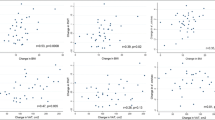Abstract
Background
Obesity frequently results in structural and physiologic changes in the cardiovascular system. Whether weight reduction leads to reversal of these changes is not well-established. This investigation sought to identify the effect of a weight reduction program on right and left ventricular structure and function.
Methods
Sixty-two patients presenting to the eating disorders clinic at a single academic institution for weight loss programs were prospectively enrolled. Baseline and follow-up transthoracic echocardiograms were obtained after at least 10% weight reduction or 6 months after baseline echocardiogram. Complete 2-dimensional echocardiograms were performed with M-mode, flow Doppler, and tissue Doppler evaluation.
Results
Patients lost an average of 28.2 ± 3 kg over a period of 266 ± 36 days. Left ventricular mass decreased significantly from 255.87 ± 12 to 228 ± 11 gm. There were no statistically significant changes in contractility or diastolic indices. The ratios of early-to-late diastolic mitral inflow velocities (E/A) increased from 1.30 ± 0.05 to 1.32 ± 0.06. The ratio of early mitral flow to early annular velocity (E/Em) also increased from 5.57 ± 0.22 cm to 5.82 ± 0.23 cm. Deceleration time increased from 213.26 ± 5.3 s to 228.47 ± 5.7 s.
Conclusions
Weight reduction is associated with decrease in left ventricular diastolic size and left ventricular mass. This weight reduction is not associated with statistically significant improvement in systolic or diastolic function.
Similar content being viewed by others
References
Flegal KM, Carroll MD, Ogden CL, et al. Prevalence and trends in obesity among US adults, 1999–2000. JAMA 2002;288:1723–27.
Haslam DW, James WP. Obesity. Lancet 2005;366:1197–209.
Schunkert H. Obesity and target organ damage: the heart. Int J Obes Relat Metab Disord. 2002;26(Suppl 4):S15–S20.
Lauer MS, Anderson KM, Kannel WB, et al. The impact of obesity on left ventricular mass and geometry. The Framingham heart study. JAMA 1991;266:231–36.
Messerli FH, Sundgaard-Riise K, Reisin ED, et al. Dimorphic cardiac adaptation to obesity and arterial hypertension. Ann Intern Med. 1983;99:757–61.
Hammond IW, Devereux RB, Alderman MH, et al. Relation of blood pressure and body build to left ventricular mass in normotensive and hypertensive employed adults. J Am Coll Cardiol. 1988;12:996–1004.
Alpert MA, Terry BE, Kelly DL. Effect of weight loss on cardiac chamber size, wall thickness and left ventricular function in morbid obesity. Am J Cardiol. 1985;55:783–86.
MacMahon SW, Wilcken DE, Macdonald GJ. The effect of weight reduction on left ventricular mass. A randomized controlled trial in young, overweight hypertensive patients. N Engl J Med. 1986;314:334–9.
Alpert MA, Lambert CR, Terry BE, et al. Effect of weight loss on left ventricular mass in non hypertensive morbidly obese patients. Am J Cardiol. 1994;73:918–21.
Kristjan K, Ingemar W, Bo L, et al. Effects of obesity and weight loss on left ventricular mass and relative wall thickness: survey and intervention study. BMJ 1997;315:912–6.
Mosteller RD. Simplified calculation of body surface area. N Engl J Med. 1987;317(17):1098, Oct 22.
Alpert MA, Terry BE, Kelly DL. Effect of weight loss on cardiac chamber size, wall thickness and left ventricular function in morbid obesity. Am J Cardiol. 1985;55:783–6.
Alexander JK, Peterson KL. Cardiovascular effects of weight reduction. Circulation 1972;45:310–8.
Fleiss JL. Statistical methods for rates and proportions, 2nd ed. New York [etc.]: Wiley; 1982.
Kaltman AJ, Goldring RM. Role of circulatory congestion in the cardiorespiratory failure of obesity. Am J Med. 1976;60:645–53.
Alexander SK, Dennis EW, Smith WG, et al. Blood volume, cardiac output, and distribution of systemic blood flow in extreme obesity. Cardiovasc Res Cent Bull. 1963;1:39.
DeDivtis O, Fazio S, Petitto M, et al. Obesity and cardiac function. Circulation 1978;58(suppl 2):230–9.
Messerli FH, Christie B, Decarvalho JGR. Obesity and essential hypertension: hemodynamics, intravascular volume, sodium excretion and plasma rennin activity. Arch Intern Med. 1981;141:81–5.
Messerli FH, Sundgaard-Riis K, Reisin ED, et al. Dimorphic cardiac adaptation to obesity and arterial hypertension. Ann Int Med. 1983;99:757–61.
Author information
Authors and Affiliations
Corresponding author
Rights and permissions
About this article
Cite this article
Syed, M., Rosati, C., Torosoff, M.T. et al. The Impact of Weight Loss on Cardiac Structure and Function in Obese Patients. OBES SURG 19, 36–40 (2009). https://doi.org/10.1007/s11695-008-9645-1
Received:
Accepted:
Published:
Issue Date:
DOI: https://doi.org/10.1007/s11695-008-9645-1




